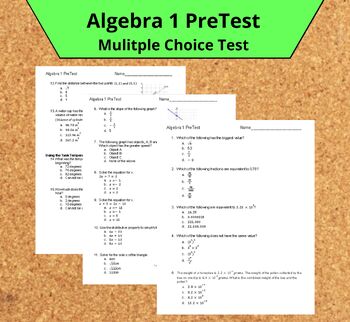Algebra 1 PreTest - Editable 15 Multiple Choice Assessment
DeBer's Bulletin
6 Followers
Grade Levels
7th - 10th
Subjects
Resource Type
Standards
CCSS8.G.B.6
CCSS8.G.B.8
CCSS8.G.C.9
CCSS8.SP.A.2
CCSS8.SP.A.3
Formats Included
- Google Docs™
Pages
6 pages
DeBer's Bulletin
6 Followers

Made for Google Drive™
This resource can be used by students on Google Drive or Google Classroom. To access this resource, you’ll need to allow TPT to add it to your Google Drive. See our FAQ and Privacy Policy for more information.
Also included in
- Included in this bunnle is a preassessment with 15 multiple choice questions and a final exam with 50 multiple choice questions.Price $7.20Original Price $8.00Save $0.80
Description
Looking for a reliable tool to assess your students' readiness for Algebra 1? Look no further than the Algebra 1 Pretest! Our multiple-choice test covers all the essential 8th-grade standards, ensuring that your students are fully prepared for success in Algebra 1. With just 15 questions, our pretest is quick and easy to administer. Plus, our detailed results report will help you identify any areas where your students may need additional support. Don't leave your students' success to chance - give them the best possible start with the Algebra 1 Pretest today!
Total Pages
6 pages
Answer Key
Included
Teaching Duration
55 minutes
Report this resource to TPT
Reported resources will be reviewed by our team. Report this resource to let us know if this resource violates TPT’s content guidelines.
Standards
to see state-specific standards (only available in the US).
CCSS8.G.B.6
Explain a proof of the Pythagorean Theorem and its converse.
CCSS8.G.B.8
Apply the Pythagorean Theorem to find the distance between two points in a coordinate system.
CCSS8.G.C.9
Know the formulas for the volumes of cones, cylinders, and spheres and use them to solve real-world and mathematical problems.
CCSS8.SP.A.2
Know that straight lines are widely used to model relationships between two quantitative variables. For scatter plots that suggest a linear association, informally fit a straight line, and informally assess the model fit by judging the closeness of the data points to the line.
CCSS8.SP.A.3
Use the equation of a linear model to solve problems in the context of bivariate measurement data, interpreting the slope and intercept. For example, in a linear model for a biology experiment, interpret a slope of 1.5 cm/hr as meaning that an additional hour of sunlight each day is associated with an additional 1.5 cm in mature plant height.






